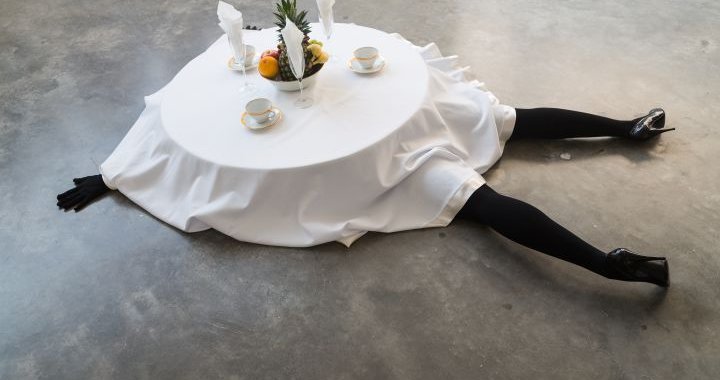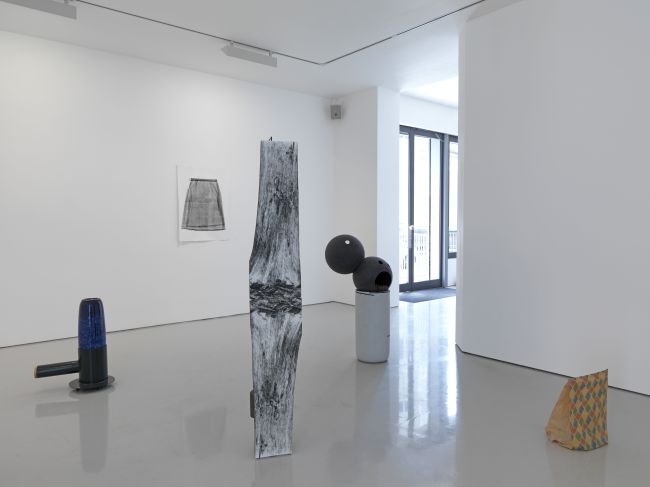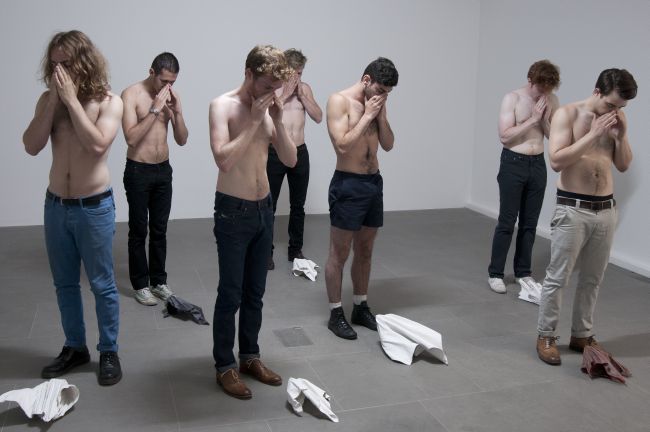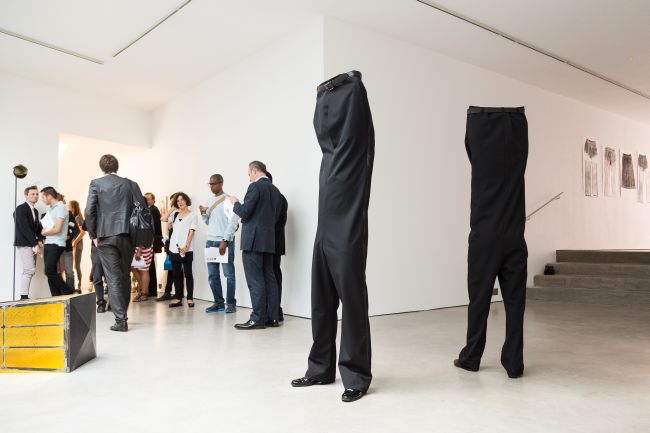
FUSIFORM GYRUS: Eggs, Bowls, Lasers and Twitter
Etsuj
24/07/2013
FUSIFORM GYRUS
Lisson Gallery, London
12 July - 7 September, 2013
Two weeks ago the Lisson Gallery opened the exhibition FUSIFORM GYRUS, curated by Raimundas Malasauskas.
The expectations around this show were extremely electrified after this year’s Venice Biennial joint Cypriot and Lithuanian Pavilion, curated by Raimundas Malasauskas, in which the former Sports Palazzo was turned into an architectural maze. This Pavilion was a radical take on curating, both through the selection of the sports hall with it’s brutalist and minimalist architecture, and in terms of the sensible presentation of artworks that corresponded to the site, affording the visitor to experience the exhibition from various vantage points. What’s more important is that Malasauska’s Pavilion offered an unexpected poetic remedy for the dying-out institutional critique of the Venice Biennial, as well as for some of it's exhausted exhibition formats.
What starts in one exhibition or book seeps into another exhibition or public presentation of Malsauska’s ouvre.
For FUSIFORM GYRUS at the Lisson Gallery, Raimundas Malasauskas collaborated with fourteen artists, four of whom also collaborated with him in the Venice Biennial this year - Phanos Kyriacou, Elena Narbutaitė, Gintaras Didžiapetris and Liudvikas Buklys.
The title of the exhibition, FUSIFORM GYRUS, refers to the part of the brain that is responsible for face recognition and the mis-recognition processes. The face recognition theme also refers to the early history of the Lisson Gallery itself – specifically, when holograms of Margaret Benyon were displayed in laser light. Here, Malasauskas connects his fascination with no-space and no-time and multiple space and time propositions, which are also mentioned in his book, Paper Exhibitions. Multiplying the vision of the curator with those of the 14 participating artists through their newly commissioned artworks, Malasauskas creates a maze in which it is impossible to find the face of the exhibition, and at the same time, also more than easy. Easy – because each artwork is an anagram of the exhibition title, but difficult – if one treats misreading as an act that cancels out the very act of understanding.

Exposition view of Koenrad Dedobeleer’s works. Photo: Ken Adlard
When walking through the gallery's rooms, I felt like at home. Beautiful sculptural objects turned the architecture of the gallery space into a domestic environment, in which each artwork has its own place, as if the objects had always been there. Koenrad Dedobeleer’s works oscillated between the familiar and the unfamiliar, leaning more towards the domestic. The soft-colored silkscreen, Machine painters, painting mystical objects (2012), carelessly floats near the wall to which it has been pinned, much like a poster in a bedroom. Some of Dedobeleer’s sculptures are functional aesthetic modernist objects, such as lamps and doorknobs (A rude awakening is due, 2012), while other objects react to the gallery's specific space, using the space for resting and smelling, or even for the acts of consuming and interacting – such as the sculpture Old sacrosand academic (2013), which has been outfitted with pistachios for the audience to consume and then throw their shells around the gallery.

Koenraad Dedobbeleer. Montage, mysticism and utopianism, 2013. Wood, steel and enamel. 50 x 125 x 75 cm. Photo: Ken Adlard
The titles of Dedobeleer’s domestic-looking pieces did not suggest any connection with the object. Taking the form of seemingly very meaningful, but out-of-context absurd aphorisms and academic rhetoric, they give no apparent explanation about the work itself. Dedobbeleer fools around with our attempts to explain sculpture by using language. The following Dedobeleer’s titles: Their honest, lubent little business (2013), A consensus-based, Consumer–driven service (2012), Unaware of the wretchedness of the human condition (2013), Profound Social Transformation (2013), and The key to the world welfare (2013) make a joke of the titles themselves, but also point to the ever-expanding possibility of misreading the title FUSIFORM GYRUS itself – by trying too hard to understand it.
Most of Dedobeleer’s objects were containers – some contained pistachios, while others looked as if there was an object inside of them, as in the piece Consisting an actual thing (2010); some consisted of gift-wrapping paper, take–away food, and bookshelves without any books. Dedobeleer’s sculptures invited visitors to not just rethink the minimalist and modernist sculptures and their rebirth in multiple variations. What the sculptures also did to the space is that they stressed both the inside and the outside, both in the sculptures and in familiar objects. They played with the idea that what is a private art gallery space can also be looked at as a private space with a sofa, TV and a cleverly-produced bowl of nuts.

Aditya Mandayam. Taksi to the Astral Plane, 2013. Goose eggs, porcelain and fabric. Dimensions variable. Photo: Ken Adlard
Aditya Mandayam, with her Taxi to the Astral Plane (2013), showed a sculpture made from goose eggs placed in porcelain and fabric. The sculpture looked as if it had been unwrapped and was ready to be consumed in the spacecraft. Sculpture being here and now, before our eyes, at the same time marked a longing for the time of future-past.


Miet Warlop. The Big Bad Cold. 10’ performance using sculpture props. Sculptures variable size in bronze-gips and wax. Photo: Ken Adlard
Miet Warlop’s The Big Bad Cold 10’, and other performances, brought a live element and an exaggerated theatricality to the exhibition. The performance The View (2013) involved a fully set table with pineapples and porcelain vases on it, while black, live legs appeared below the table, moving and standing together with the table. A living sculpture was formed: a table becoming a person, and a person becoming a table and food.

Elena Narbutaite. Forms Surf Guy I, 2013. Laser. Dimensions variable. Photo: Ken Adlard
In the front gallery, the Lithuanian artist Elena Narbutaitė had installed her laser-sculpture Forms Surf Guy I (2013), which was produced in collaboration with laser engineer Dr. Viktoras Vaičikauskas and a laboratory in Vilnius. It is already her second electricity-based work produced after the Venice Biennial. In Venice she installed the walking-door piece Untitled, 2013, which was so forceful that it even burned a hole in the wall.
In the Lisson Gallery, her sculpture is a laser that Narbutaitė calls “a sculpture of a stretched plane that is hanging in the air”. When thinking about lasers, one thinks of light shows, stroboscopes, DVD players, bar-code printers, laser surgery and the war industry. But firstly, the laser is a synthetic invention and a way of designing light. For FUSIMOR GYRUS, Elena Narbutaitė first had an idea which later became a laser design concept, and only then the form itself. This transformation of the idea allows the viewer to observe the laser sculpture in an unusual way – by taking a look at the laser in a calm environment. Here in the art gallery, one can look very closely at the laser and observe it from different angles, slowly. It is a sculpture that cannot be touched, yet it occupies the space and makes its own colour.

Miet Warlop. The Board, 2013. Metal frame, styrofoam, fabric and shoes. 177 x 43 x 34 cm. Photo: Marc Blower
One never thinks of lasers as sculptures, nor as a cause of synthetic euphoria, fainting, or blindness. Blindness can be cured, but also induced, by laser. If the laser light is too strong for the eye, it can be the first and last time you look at a laser. Hence the exhibition's title. If you look too long at something, it looses its meaning. You loose the ability and possibility to recognise a face.
Whose face can be recognised after looking at the laser, if the viewer has not yet been blinded? What are the figurative pointers to which the viewing eye could find rest from the maze and loops of thoughts?
Maybe one could take a rest while looking at Malasaukas’s face in a hologram, produced in 2007. It is an image of the face of a curator, caught in the hologram and in multiple moments that took place in the past.


Miet Warlop’s performance. Photo: Marc Blower
Or, maybe one can find relief in Miet Warlop’s humorous performances. Or, maybe after the opening, in which we watched the laser-like red and yellow urine-like streams that performers squirted on the walls of the Lisson Gallery's courtyard? If this is the final say, then what was hiding behind the laughter and whispers of Miet Warlop’s performers while they were peeing the sculpture and spraying the painting? Possibly, it is once again a wish to fool around, like Dedobeleer did with his witty titles.

Rosalind Nashashibi. R Guys or I Muffs? , 2013. Photo: Marc Blower

Alex Bailey. Simon Bailey, 2008. Pastel on canvas. 45 x 27 cm. Photo: Marc Blower
In continuation of the puzzle, the exhibition has also added sculptures onto the Internet.
A Twitter feed of quite abstract and guiding sentences concerning FUSIFORM GYRUS was started on 8 July. FUSIFORM GYRUS is a person and an exhibition that says: I am FUSIFORM GYRUS and faces amaze me 11 July/ I am Fusiform and faces are a maze to me 11 July/ Uses of Facial Forms and participants all over the world debated which one was to be called the blind object: inside or outside 12 July/.
Better go inside the exhibition and decide for yourself.
An interview with the curator and performance documentation: https://www.youtube.com/watch?v=t7Cw4MkGSTQ&feature=youtu.be
The exhibition is open until 7 September 2013 - at 29 & 52-54 Bell Street, London, UK
Artists: Alex Bailey, Liudvikas Buklys, Eduardo Costa, Koenraad Dedobbeleer, Gintaras Didžiapetris, Elizabeth Hoak-Doering, Phanos Kyriacou, Aditya Mandayam, Darius Mikšys, Elena Narbutaitė, Rosalind Nashashibi, Sasha Suhareva, Ola Vasiljeva, Miet Warlop.

Raimundas Malašauskas
About the curator:
Raimundas Malašauskas, born in Vilnius, is a curator and writer. From 1995 to 2006 he worked at the Contemporary Art Centre in Vilnius, where he produced the first two seasons of the weekly television show ‘CAC TV’, an experimental merger of commercial television and contemporary art that ran under the slogan ‘Every program is a pilot. Every program is the final episode.’ He curated ‘Black Market Worlds’, the IX Baltic Triennial, at CAC Vilnius in 2005.
From 2007 to 2008 Malašauskas was a visiting curator at the California College of the Arts, San Francisco, and, until 2010, a curator-at-large of Artists Space, New York. In 2007 he co-wrote the libretto Gellar Door, an opera by Loris Gréaud produced in Paris. He has curated the exhibitions ‘Sculpture of the Space Age’, David Roberts Art Foundation, London (2009); ‘Into the Belly of a Dove’, Museo Rufino Tamayo, Mexico City (2010); and ‘Repetition Island’, Centre Georges Pompidou, Paris (2010).
Recently he worked as one of the agents of dOCUMENTA 13. He is currently curating ‘oO’, an exhibition for the Lithuanian and Cypriot pavilions at the 55th Venice Biennale.
Paper Exhibition, a book of Malašauskas’s selected writings, was recently published by Sternberg Press. His ongoing projects include ‘Clifford Irving Show’ and ‘Hypnotic Show’. Iterations or documentation of his projects can be found at www.rye.tv